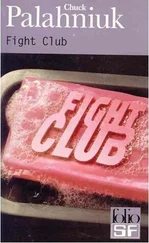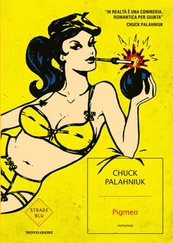Chuck Palahniuk - Fugatives & Refugees
Здесь есть возможность читать онлайн «Chuck Palahniuk - Fugatives & Refugees» весь текст электронной книги совершенно бесплатно (целиком полную версию без сокращений). В некоторых случаях можно слушать аудио, скачать через торрент в формате fb2 и присутствует краткое содержание. Жанр: Современная проза, на английском языке. Описание произведения, (предисловие) а так же отзывы посетителей доступны на портале библиотеки ЛибКат.
- Название:Fugatives & Refugees
- Автор:
- Жанр:
- Год:неизвестен
- ISBN:нет данных
- Рейтинг книги:5 / 5. Голосов: 1
-
Избранное:Добавить в избранное
- Отзывы:
-
Ваша оценка:
- 100
- 1
- 2
- 3
- 4
- 5
Fugatives & Refugees: краткое содержание, описание и аннотация
Предлагаем к чтению аннотацию, описание, краткое содержание или предисловие (зависит от того, что написал сам автор книги «Fugatives & Refugees»). Если вы не нашли необходимую информацию о книге — напишите в комментариях, мы постараемся отыскать её.
Fugatives & Refugees — читать онлайн бесплатно полную книгу (весь текст) целиком
Ниже представлен текст книги, разбитый по страницам. Система сохранения места последней прочитанной страницы, позволяет с удобством читать онлайн бесплатно книгу «Fugatives & Refugees», без необходимости каждый раз заново искать на чём Вы остановились. Поставьте закладку, и сможете в любой момент перейти на страницу, на которой закончили чтение.
Интервал:
Закладка:
Jane says, "On the national level, there's a 'buzz' about the Portland art scene." She explains that the lower cost of living here has attracted a glut of quality artists from other cities. Unfortunately, the Portland "collecting base" is small, with a big resistance to high prices. This makes for a buyers' market—an overabundance of quality art at low, low prices.
If you're brave enough to gate crash, you might walk into the exclusive "First Wednesday," when Jane says the galleries make their real money. It's the day before each "First Thursday"—usually by invitation only—but few galleries will check you at the door. Really, their biggest concern might be losing their special liquor license if too many of the general public walk in. But, Jane says, "If you come, they probably won't turn you away."
6. Count the Hippos
Hippo Hardware & Trading Company is called the "Holding and Fondling Museum" because of Ralph Jacobson, who ran his Good Used Furniture store for years in the Barber Block on SE Grand Avenue. It was Ralph who taught Hippo partners Stephen Oppenheim and Steve Miller how to fondle something at auction and feel the difference between bronze or brass and worthless pot metal despite layers of paint or rust.
"It really is a handling and fondling business," Oppenheim says.
The store's dancing hippo logo is based on local hairdresser Patty DeAngelo, who loves to roller-skate at Oakes Park Roller Rink. The way the hippo flails with one arm and one leg in the air is how Patty looks as she's thrown free during crack-the-whip. The hippos painted on the columns that line the store along E Burnside Street were done by street artist Andy Olive, who still lives under the freeway on-ramp to Interstate 84 off NE Sixteenth Avenue. They're the only part of the building not marked by graffiti taggers.
"We're protected by the Curse of the Hippo," Oppen-heim says. "Since we had them done by a street artist, anyone who ruined them would be known on the street."
Since opening in 1977, Hippo Hardware has been a clearinghouse for chunks of Portland history. Look for light fixtures and architectural details from the Portland Hotel (1890-1951), the Benson Hotel, the Central Library, and City Hall. A gingerbread arch from the Hoyt Hotel hangs in one room. In the past Hippos also outfitted local movie sets. "The first time we saw Madonna naked, it was under our lights," Oppenheim says, referring to the acupuncture scene from Body of Evidence. In The War of the Roses, after Kathleen Turner bites Michael Douglass testicles, he sits on a black bidet that Hippo bought and resold. "If anyone in Portland has a black bidet," he says, "that's the one. There's not a lot of black bidets floating around this town."
Kids have counted more than three hundred hippos hiding in the store. Toys, dolls, and statues, Oppenheim says the best is a huge stuffed pink hippo that a well-dressed woman threw at the store one day, shouting, "I've been at yard sales all day, and this is the best thing I could find. Here, it's yours!" before she roared away in her Cadillac.
Oppenheim tells the story of his store's last location, prior to 1991, on SE Twelfth Avenue, the site of three murders and years of poltergeist hijinks. There one day, Oppenheim saw an old man stumbling down the stairs from the apartments on the second floor. The man was flushed and sweating, trembling as he talked about his first day as a rookie cop in Portland in the 1940s. A couple in the apartment in the south end of the second floor had fought and the wife had dismembered her husband with an ax. In the claw-foot tub she'd stripped the meat from his bones. She'd called her sister, a stripper who danced with a boa constrictor, and said there was enough meat to feed the snake for a year. The stripper sister explained that boas only eat live food and then called the police. The old man, now in his seventies, told Oppenheim how he'd arrived at the murder scene to find blood on the stairs. The second-floor landing was a pool of blood, and the messy skeleton in the claw-foot bathtub was something he'd never forget.
When Oppenheim found the old cop sweating and shaking on the stairs, the man had come back for his first look in forty years. "The bathtub," Oppenheim says, "is still there."
Another night, an employee was alone in the store when a single hanging light on display started to swing. Then another and another, until all the hanging lamps and chandeliers were swinging without a draft to explain it. At that point the employee panicked and left.
In 1991 the store used shopping carts and "the philosophy of leaf-cutter ants" to haul the inventory to the current building at 1040 E Burnside. Still, despite the "Curse of the Hippo," watch your step. Customers tell Oppenheim that his new store is just as haunted.
7. The World's Largest Hair Ball
The Lord does work in very mysterious ways. To see the hair ball—a 2.5-pound wad of calcium and hair, cut from the gut of a three-hundred-pound pig in the 1950s—and the whole collection of deformed and stuffed animals, take an hour and drive south on Interstate 5. Take the Wood-burn exit and follow the signs for Highway 99E to Mount Angel. The exhibit is in a self-guided museum at the Benedictine Mount Angel Abbey and Seminary. Not for the queasy.
8. Bob's Red Mill Flour
In 1977, Bob and Charlee Moore were walking near Dufur, Oregon. "Down in this little draw," Bob says, "was a little old building, and I told my wife, 'That's an old flour mill.'"
It was the Dufur White Flour Mill, which operated from 1872 through the 1930s, using millstones that had come around the Cape of Good Hope in 1870. Today, those stones are grinding again, twenty-four hours a day. Turning at 125 rotations per minute, they chew up six hundred pounds of wheat per hour at Bob's Red Mill Flour, 5209 SE International Way. Phone: 503-654-3215.
The Moores started grinding flour on a five-acre farm outside of Redding, California, in the mid-1950s. In 1972 they started commercial milling after Bob read the book John Goffe's Mill, by George Woodbury. "I was at the library," Bob says, "and the book was just lying there on the table. It was like some angel pointed it out to me. It really became practical after I read this. I thought, 'I can do this.'"
With his square gray beard and eyeglasses, Bob looks like a transplant from the 1800s. With the sense of wonder still in his voice, he says, "We were just enthralled with the fact we could put grain in here and get flour out here. "
The Moores opened their Portland mill in 1978, but in 1988 a fire destroyed it. Most of his milling equipment was lost, but several tons of grain poured down and buried the century-old millstones from Dufur, saving them. The millstones are four feet in diameter, with the top stone weighing two thousand pounds. They're quartz, quarried forty miles east of Paris in a quarry used since the 1300s for millstones. Only these surviving stones made the trip to the mill's new 50,000-square-foot factory and adjacent distribution center.
Moore's partner, Dennis Gilliam, calls Bob the "foremost authority on stone-grinding in the entire world." Dennis says, "Some people know the history of milling. Some collect the stones. Some run the old mills. But Bob Moore combines all those people." Bob travels to Scotland to study the grind for Scottish oatmeal. He and Dennis meet with home-baking giants like Betty Crocker. "They envy us," Dennis says. "All they do all day is sell white flour, while we might be milling amaranth and millet and flax seeds."
Watch for Bob and Dennis to open a new mill and museum next to their current one. With a waterwheel and historic mills and stones, the museum will make anyone an expert on milling. Not that Bob ever wanted to be an expert... "I just wanted to run a little mill where I could retire and drink coffee and talk to customers," he says. "It's like you're in a fog, and you can't see ahead, but you keep walking because you're so curious. You just keep taking step after step after step."
Читать дальшеИнтервал:
Закладка:
Похожие книги на «Fugatives & Refugees»
Представляем Вашему вниманию похожие книги на «Fugatives & Refugees» списком для выбора. Мы отобрали схожую по названию и смыслу литературу в надежде предоставить читателям больше вариантов отыскать новые, интересные, ещё непрочитанные произведения.
Обсуждение, отзывы о книге «Fugatives & Refugees» и просто собственные мнения читателей. Оставьте ваши комментарии, напишите, что Вы думаете о произведении, его смысле или главных героях. Укажите что конкретно понравилось, а что нет, и почему Вы так считаете.




